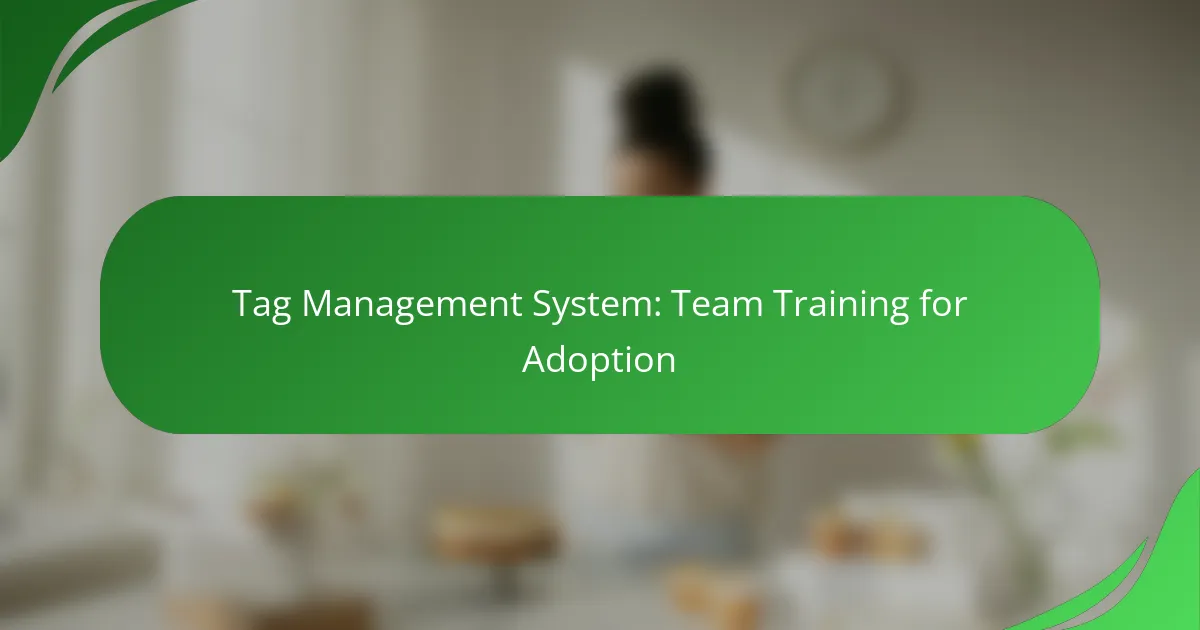Training teams for the adoption of a Tag Management System (TMS) is essential for maximizing its benefits and enhancing digital performance. By utilizing a blend of practical workshops, online resources, and collaborative learning, organizations can ensure that their members gain the necessary skills to effectively manage tags. This comprehensive approach not only fosters engagement but also leads to improved efficiency and streamlined processes across digital platforms.

How to train teams for Tag Management System adoption in Canada?
Training teams for Tag Management System (TMS) adoption in Canada involves a combination of practical workshops, online resources, and collaborative learning. This multifaceted approach ensures that team members are equipped with the necessary skills and knowledge to effectively utilize the TMS.
Hands-on workshops
Hands-on workshops are essential for providing practical experience with a Tag Management System. These sessions should focus on real-world scenarios that team members encounter, allowing them to practice implementing tags and troubleshooting issues in a controlled environment.
Consider scheduling these workshops regularly, ideally in small groups, to foster interaction and personalized guidance. Aim for sessions lasting a few hours to a full day, depending on the complexity of the topics covered.
Online training modules
Online training modules offer flexibility for team members to learn at their own pace. These modules should cover the fundamentals of TMS, including setup, management, and best practices. Incorporate quizzes and interactive elements to reinforce learning and assess understanding.
Utilize platforms that are accessible to all team members, ensuring that the content is relevant to the Canadian market. Aim for modules that take between 30 minutes to an hour to complete, allowing for easy integration into busy schedules.
Peer mentoring programs
Peer mentoring programs can enhance TMS adoption by pairing less experienced team members with those who have more expertise. This collaborative approach encourages knowledge sharing and builds confidence in using the system.
Establish a structured mentoring framework, including regular check-ins and goal-setting sessions. Encourage mentors to share practical tips and real-life examples to help mentees navigate challenges effectively.
Case studies from Canadian companies
Reviewing case studies from Canadian companies that successfully adopted a Tag Management System can provide valuable insights. These examples highlight best practices, common pitfalls, and the tangible benefits of effective TMS implementation.
Focus on case studies that detail specific outcomes, such as improved website performance or enhanced marketing analytics. This contextual understanding can motivate teams and illustrate the practical advantages of adopting a TMS in their own operations.

What are the best practices for Tag Management System training?
Effective training for a Tag Management System (TMS) focuses on practical application, clear objectives, and engaging methods. By implementing best practices, teams can enhance their understanding and adoption of the TMS, leading to improved performance and efficiency.
Define clear objectives
Establishing clear objectives is crucial for successful TMS training. Objectives should outline what team members need to learn, such as how to implement tags, manage triggers, and analyze data effectively.
Consider using the SMART criteria—Specific, Measurable, Achievable, Relevant, and Time-bound—to set these objectives. For instance, aim for team members to create and publish a tag within a specific timeframe, ensuring they understand the process thoroughly.
Utilize real-world scenarios
Incorporating real-world scenarios into TMS training helps bridge the gap between theory and practice. Use case studies or examples from your organization to illustrate how the TMS can solve specific problems or enhance marketing efforts.
For example, demonstrate how a particular tag can track user behavior on a website and lead to actionable insights. This contextual learning makes the training more relevant and engaging for participants.
Encourage interactive learning
Interactive learning fosters engagement and retention during TMS training. Encourage team members to participate in hands-on activities, such as tag creation workshops or group discussions about best practices.
Consider using tools like quizzes or gamified learning modules to reinforce knowledge. This approach not only makes the training enjoyable but also helps identify areas where additional support may be needed.

What tools can enhance Tag Management System training?
Several tools can significantly improve Tag Management System (TMS) training by providing intuitive interfaces, robust documentation, and community support. These tools facilitate hands-on learning and help teams effectively implement and manage tags across digital platforms.
Google Tag Manager
Google Tag Manager (GTM) is a widely used tool that simplifies the process of managing tags on websites and mobile apps. It allows users to deploy tags without modifying the underlying code, which can speed up training and reduce reliance on developers.
To get started with GTM, teams should focus on understanding its key features, such as triggers, variables, and tags. A practical approach is to create a test container where team members can practice adding and configuring tags in a risk-free environment.
Common pitfalls include neglecting to test tags before publishing and failing to maintain organized naming conventions. Regular audits of the tag setup can help prevent these issues.
Tealium
Tealium is another powerful TMS that offers a comprehensive suite of tools for tag management, data integration, and customer data platforms. Its user-friendly interface and extensive documentation make it suitable for teams looking to enhance their TMS skills.
When training with Tealium, focus on its features like the Universal Tag and EventStream, which allow for seamless data collection and management. Teams should consider setting up a sandbox environment to experiment with different configurations and data flows.
It’s essential to ensure that team members understand the importance of data privacy regulations, such as GDPR, when using Tealium. Regular training sessions on compliance can help mitigate risks associated with data handling.
Adobe Experience Platform
Adobe Experience Platform (AEP) provides a robust framework for managing tags alongside customer data and analytics. It integrates well with other Adobe products, making it a strong choice for organizations already invested in the Adobe ecosystem.
Training on AEP should emphasize its capabilities for real-time data collection and audience segmentation. Teams can benefit from hands-on workshops that guide them through setting up tags and leveraging AEP’s analytics features.
To maximize effectiveness, avoid overwhelming team members with too much information at once. Break down training into manageable sessions that focus on specific functionalities, ensuring that each participant gains confidence in using the platform.

How to measure the effectiveness of training programs?
To measure the effectiveness of training programs, focus on gathering data through various methods that assess participant feedback, performance improvements, and the rate of adoption of new skills or tools. This multifaceted approach provides a comprehensive view of how well the training meets its objectives.
Feedback surveys
Feedback surveys are a direct way to gauge participant satisfaction and perceived value of the training. These surveys should include questions about content relevance, delivery effectiveness, and overall engagement. Aim for a mix of quantitative ratings and qualitative comments to capture a full spectrum of insights.
Consider using a Likert scale for responses, allowing participants to rate their experience from “very dissatisfied” to “very satisfied.” This structured feedback can help identify areas for improvement and highlight successful aspects of the training.
Performance metrics analysis
Analyzing performance metrics involves comparing key indicators before and after training. Look for improvements in productivity, error rates, or task completion times that can be attributed to the training. For example, if a team’s project completion time decreases significantly post-training, this indicates effective learning.
Establish baseline metrics prior to training to facilitate accurate comparisons. Regularly review these metrics over time to assess long-term retention and application of skills learned during training sessions.
Adoption rate tracking
Tracking adoption rates measures how effectively team members implement new skills or tools introduced during training. This can be done by monitoring usage statistics or observing changes in workflow practices. A high adoption rate suggests that the training was successful in equipping participants with necessary skills.
Set clear benchmarks for what constitutes successful adoption, such as a specific percentage of team members using a new tool within a set timeframe. Regular check-ins can help identify challenges and provide support to those who may be struggling with the transition.

What are common challenges in Tag Management System training?
Common challenges in Tag Management System (TMS) training include resistance to change, lack of resources, and insufficient management support. Addressing these issues is crucial for successful adoption and effective use of the system.
Resistance to change
Resistance to change is a significant barrier when implementing a Tag Management System. Team members may be accustomed to existing processes and hesitant to adopt new tools, fearing disruption to their workflow.
To mitigate this resistance, involve team members early in the training process. Highlight the benefits of the TMS, such as improved efficiency and better data management, to encourage buy-in.
Lack of resources
A lack of resources can hinder effective training for a Tag Management System. This includes insufficient time, budget, or personnel dedicated to the training process, which can lead to incomplete understanding and implementation.
To overcome this challenge, prioritize training sessions and allocate a specific budget for TMS education. Consider utilizing online resources or workshops to maximize learning while minimizing costs.
Insufficient management support
Insufficient management support can severely impact the success of TMS training. Without backing from leadership, teams may lack motivation and feel undervalued, which can lead to poor adoption rates.
To ensure management support, present a clear business case for the TMS, demonstrating how it aligns with organizational goals. Regularly update leadership on training progress and successes to maintain their engagement and commitment.

How to create a Tag Management System training roadmap?
Creating a Tag Management System (TMS) training roadmap involves outlining the necessary skills and knowledge required for effective adoption. This roadmap should focus on the specific roles within your team and the tools they will use to manage tags efficiently.
Identify key stakeholders
Identifying key stakeholders is crucial for a successful TMS training roadmap. Stakeholders typically include marketing teams, web developers, data analysts, and compliance officers, as each group will interact with the TMS in different ways.
Engage these stakeholders early in the process to understand their needs and expectations. This can be done through interviews or surveys to gather insights on their current challenges and desired outcomes regarding tag management.
Once identified, establish a communication plan to keep stakeholders informed and involved throughout the training process. Regular updates and feedback sessions can help ensure that the training aligns with their requirements and fosters a collaborative environment.



